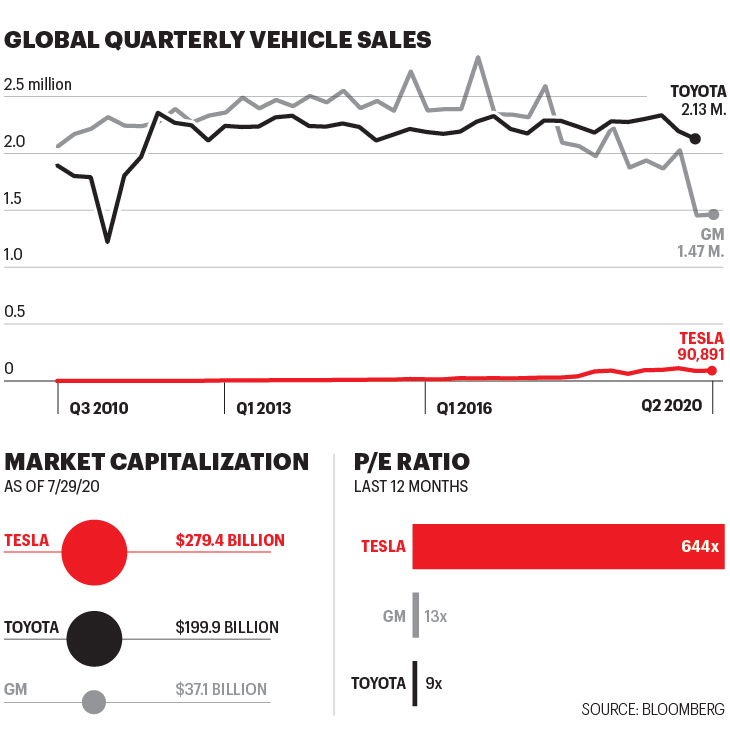
7月1日,特斯拉股价一路飙升,市值达到了惊人的2090亿美元,让这家诞生仅17年的电动汽车制造商坐上了全球车企市值的头把交椅。而一个月后,特斯拉的市值更是达到了2790亿美元,至此,虽然特斯拉的汽车销量仅相当于通用汽车和福特两大汽车巨头的4%,但其市值却已经超出底特律双雄市值之和的四倍有余。取得如此成绩,几乎可以想象到马斯克脸上满意的笑容。

那么特斯拉的实际销售量要达到多少才能满足投资者的超额预期呢?为了回答这一问题,我们邀请了坚定看好特斯拉前景的摩根大通证券分析师乔·奥沙帮我们算了一笔账。按照他的计算,特斯拉需要在2025年前实现250万辆汽车的年销量(即去年销量的7倍),才能匹配自己的高估值。
这一数字是如何得出的呢?根据奥沙的估计,到2025年,全球电动汽车市场(特斯拉目前占有约三分之一的市场份额)的规模将达到600万辆,约占全球汽车市场总规模的8%。他表示,如果低成本的中国制造电动汽车能够占据全球大部分电动汽车市场,则特斯拉及其同行将获得超过450万辆的市场份额。奥沙认为,由于特斯拉的产品在竞争中处于优势地位,其将从中分得最大的一块蛋糕,即每年250万辆的市场份额。
而要想满足这么庞大的市场需求,特斯拉自然需要提升自己的产能。据特斯拉自己表示,到2021年年底,其上海工厂、加州弗里蒙特工厂及正在建设中的柏林工厂将具备每年交付110万辆汽车的能力。而奥沙认为,“特斯拉即便不新设生产地点或制定具体增产计划,增产到250万辆也并非不可能”。
同时,奥沙表示,到2025年前,特斯拉的息税折旧摊销前利润率(Ebitda)将达到20%(包括2%的股权激励费用),而要达到这一数字,特斯拉以通用会计准则计算的毛利率需要保持在21%到25%之间。特斯拉最近一个季度包括工厂折旧、人工和材料成本在内的毛利率为21%,奥沙认为,随着规模经济发挥作用,特斯拉的毛利率水平将会有所提高。
他说,在考虑到风险和机会成本的前提下,使用20倍Ebitda乘数对所有这些因素进行计算可以得出,特斯拉的市值到2025年将达到4000亿美元左右,而现在则应该为3000亿美元左右。
“特斯拉可能会取得我们所设想的那种成功,也可能不会。” 奥沙说,“但从创立时的一文不名,到现在已经能够每年售出50万台汽车,这样一家快速发展的企业理应得到我们的重视。”(财富中文网)
本文另一版本刊载于《财富》杂志2020年8/9月刊。
译者:Feb
7月1日,特斯拉股价一路飙升,市值达到了惊人的2090亿美元,让这家诞生仅17年的电动汽车制造商坐上了全球车企市值的头把交椅。而一个月后,特斯拉的市值更是达到了2790亿美元,至此,虽然特斯拉的汽车销量仅相当于通用汽车和福特两大汽车巨头的4%,但其市值却已经超出底特律双雄市值之和的四倍有余。取得如此成绩,几乎可以想象到马斯克脸上满意的笑容。
那么特斯拉的实际销售量要达到多少才能满足投资者的超额预期呢?为了回答这一问题,我们邀请了坚定看好特斯拉前景的摩根大通证券分析师乔·奥沙帮我们算了一笔账。按照他的计算,特斯拉需要在2025年前实现250万辆汽车的年销量(即去年销量的7倍),才能匹配自己的高估值。
这一数字是如何得出的呢?根据奥沙的估计,到2025年,全球电动汽车市场(特斯拉目前占有约三分之一的市场份额)的规模将达到600万辆,约占全球汽车市场总规模的8%。他表示,如果低成本的中国制造电动汽车能够占据全球大部分电动汽车市场,则特斯拉及其同行将获得超过450万辆的市场份额。奥沙认为,由于特斯拉的产品在竞争中处于优势地位,其将从中分得最大的一块蛋糕,即每年250万辆的市场份额。
而要想满足这么庞大的市场需求,特斯拉自然需要提升自己的产能。据特斯拉自己表示,到2021年年底,其上海工厂、加州弗里蒙特工厂及正在建设中的柏林工厂将具备每年交付110万辆汽车的能力。而奥沙认为,“特斯拉即便不新设生产地点或制定具体增产计划,增产到250万辆也并非不可能”。
同时,奥沙表示,到2025年前,特斯拉的息税折旧摊销前利润率(Ebitda)将达到20%(包括2%的股权激励费用),而要达到这一数字,特斯拉以通用会计准则计算的毛利率需要保持在21%到25%之间。特斯拉最近一个季度包括工厂折旧、人工和材料成本在内的毛利率为21%,奥沙认为,随着规模经济发挥作用,特斯拉的毛利率水平将会有所提高。
他说,在考虑到风险和机会成本的前提下,使用20倍Ebitda乘数对所有这些因素进行计算可以得出,特斯拉的市值到2025年将达到4000亿美元左右,而现在则应该为3000亿美元左右。
“特斯拉可能会取得我们所设想的那种成功,也可能不会。” 奥沙说,“但从创立时的一文不名,到现在已经能够每年售出50万台汽车,这样一家快速发展的企业理应得到我们的重视。”(财富中文网)
本文另一版本刊载于《财富》杂志2020年8/9月刊。
译者:Feb
You could practically see Elon Musk smile.On July 1, after an impressive rally of its stock price, Tesla—the 17-year-old electric-car company for which Musk serves as CEO—became the world’s most valuable automaker, worth an eye-watering $209 billion.Barely a month later, it’s worth $279 billion—more than quadruple the combined value of American icons General Motors and Ford Motor, even though the California company sold just 4% of the vehicles the Detroit duo did last year.
How substantial must Tesla’s actual sales be to meet its investors’ outsize expectations? We asked Joe Osha, a JMP Securities analyst who specializes in energy and industrial tech—and a frequent Tesla bull—to show his math.By his calculation Tesla needs to sell 2.5 million vehicles per year, or almost seven times what it managed last year, by 2025 to justify its lofty valuation.
How did Osha arrive at that number? The analyst estimates that the global EV market—of which Tesla controls nearly a third today—will represent 6 million vehicles per year by 2025, or about 8% of the total global vehicle market.If a substantial share of the EV market goes to low-cost Chinese vehicles, he says, that leaves upwards of 4.5 million units to Tesla and its peers.Osha believes Tesla will capture the lion’s share of this portion—2.5 million per year—because “they’re ahead of the competition on product.”
Tesla, of course, requires the production capacity to support that kind of output.The automaker itself says its factories in Berlin (under construction), Shanghai, and Fremont, Calif., will support 1.1 million vehicles by the end of 2021.But Osha believes that “continued expansion to 2.5 million units is plausible even if we don’t have specific locations or plans” for new factories.
In the meantime, Osha says Tesla’s Ebitda margin will reach 20% (including stock-based compensation—about 2% for Tesla) by 2025, requiring a GAAP gross margin between 21% and 25%.The company’s current gross margin— 21% in its latest quarter—includes factory depreciation, labor, and materials; Osha believes it will improve with modest economies of scale.
Add it all up using the ubiquitous 20X Ebitda multiple, and Tesla will be an automaker worth somewhere in the ballparkof $400 billion in 2025, Osha says—or about $300 billion today, taking risk and opportunity cost into consideration.
“Tesla may or may not end up as successful as we think it will be,” he says.“But this company went from barely existing to selling half-a-million units a year.It should be valued like a growth company.”
A version of this article appears in the August/September 2020 issue of Fortune magazine.






